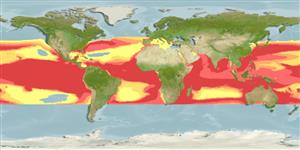分類 / Names
俗名 | 同種異名 | Catalog of Fishes(屬, 種) | ITIS | CoL | WoRMS | Cloffa
Elasmobranchii
板鰓亞綱 (鯊魚與魟魚) (sharks and rays) >
Carcharhiniformes (Ground sharks)
真鯊目 (Ground sharks) >
Sphyrnidae (Hammerhead, bonnethead, or scoophead sharks)
丫髻鮫科 (Hammerhead, bonnethead, or scoophead sharks)
Etymology: Sphyrna: Probable misspelling of sphyra (Gr.), hammer, referring to their hammer-shaped heads (See ETYFish); lewini: Patronym not identified, perhaps in honor of John Lewin (1770-1819), who illustrated early volumes of Australian natural history (this shark was described from Australia) and may be the “Mr. Lewin” who illustrated the plates in Griffith and Smith’s book (See ETYFish).
Eponymy: John William Lewin (1770–1819) was an English naturalist and engraver. [...] (Ref. 128868), visit book page.
Environment: milieu / climate zone / depth range / distribution range
生態學
海洋; 半鹹淡水; 海洋洄游的 (Ref. 51243); 深度上下限 0 - 1043 m (Ref. 89972), usually 0 - 25 m (Ref. 26999). 亞熱帶的; 46°N - 39°S, 180°W - 180°E
Circumglobal in coastal warm temperate and tropical seas (Ref. 13562). Western Atlantic: New Jersey, USA to Uruguay (Ref. 58839), including the Gulf of Mexico and Caribbean. Eastern Atlantic: western Mediterranean (Ref. 6678) to Namibia (Ref. 6812). Indo-Pacific: Persian Gulf (Ref. 68964), Red Sea, East Africa and throughout the Indian Ocean; Japan to New Caledonia, Hawaii and Tahiti. Eastern Pacific: southern California, USA to Ecuador, probably Peru.
環球分佈於海岸的暖溫帶與熱帶的海洋.(參考文獻 13562) 西大西洋: 美國的紐澤西到烏拉圭 (參考文獻 58839), 包括墨西哥灣與加勒比海。 東大西洋: 地中海西部 (參考文獻 6678) 到那米比亞.(參考文獻 6812) 印度-太平洋: 紅海, 東非與在印度洋各處; 日本到新加勒多尼亞,夏威夷與大溪地島。 東太平洋: 美國的南加州到厄瓜多, 可能祕魯。
Length at first maturity / 大小 / 重量 / 年齡
Maturity: Lm 210.5, range 140 - 273 cm
Max length : 430 cm TL 雄魚/尚未辨別雌雄; (Ref. 26938); common length : 360 cm TL 雄魚/尚未辨別雌雄; (Ref. 13562); 最大體重: 152.4 kg (Ref. 40637); 最大年齡: 35 年 (Ref. 31395)
背棘 (總數) : 0; 臀棘: 0. This hammerhead shark is distinguished by having the following characters: large, moderately slender body; broad, narrow bladed head, arched anterior margin with prominent median indentation and lateral indentation; nostrils with strong prenarial grooves; hind margins of eyes slightly posterior to or nearly opposite front of mouth; teeth triangular, deeply notched posteriorly, with smooth or finely serrated edges; first dorsal fin moderately high, second dorsal and pectoral fins low; upper precaudal pit transverse crescentric. Colour of body light grey or greyish brown above, shading to white below, pectoral fin tips dusky and a dark blotch on lower caudal fin lobe (Ref. 13562, 114967).
大的 hammerhead 在頭部的中心具有一個凹槽; 第一背鰭一般高, 第二背鰭與腹鰭低的.(參考文獻 5578) 頭部的前緣寬廣弓形有突出的中央凹槽。 頭部的側邊翼狹窄的, 後緣向後地清掃了.(參考文獻 26938) 均勻的灰色﹐淺灰褐色﹐或橄欖色的上方, 顏色變化成腹面白色的; 頂端的胸鰭有灰色的或黑色的腹地.(參考文獻 13562)
A coastal-pelagic, semi-oceanic shark occurring over continental and insular shelves and adjacent deep water, often approaching close inshore and entering enclosed bays and estuaries (Ref. 244, 11230, 58302). Found in inshore and offshore waters to about 275 m depth (Ref. 26938, 11230, 58302); has been filmed at a baited camera in 512 m depth (Lis Maclaren, pers. comm. 2005). Huge schools of small migrating individuals move pole ward in the summer in certain areas (Ref. 244). Permanent resident populations also exist (Ref. 244). Juveniles occur in coastal areas (Ref. 58784). Adults solitary, in pairs, or schools; young in large schools (Ref. 13562). Feed mainly on teleost fishes and cephalopods (Ref. 6871), also lobsters, shrimps, crabs (Ref. 30573), including other sharks and rays (Ref. 37816). Viviparous (Ref. 50449). Mature females produce 15-31, of 43-55 cm young in a litter (Ref. 26938, 1602). Considered potentially dangerous to people but often not aggressive when approached by divers (Ref. 13562). Readily available to inshore artisanal and small commercial fisheries as well as to offshore operations (Ref. 13562). Sold fresh, dried-salted, smoked and frozen; also sought for its fins and hides (Ref. 9987). Oil used for vitamins and carcasses for fishmeal (Ref. 13562). Maximum depth from Ref. 125614.
沿岸及大洋性, 半-大洋性的鯊魚,出現大陸棚與島嶼棚之上與毗連的深水域, 時常接近近岸而且進入封閉的海灣與河口.(參考文獻 244,11230,58302) 發現於.近岸與外海水域到大約 275 公尺深;(參考文獻 26938,11230,58302) 已經在 512 公尺深中的一台被以餌引誘的相機被薄膜 (李 Maclaren , pers. Comm。 2005)。 小的移動個體移動桿的極大魚群在特定的區域中守護夏天時。 (參考文獻 244) 永久的定居族群也存在。 (參考文獻 244) 成魚獨居性, 成對, 或魚群; 幼魚在大群魚群。 (參考文獻 13562) 主要吃硬骨魚與頭足類動物 (參考文獻 6871), 也龍蝦,蝦,螃蟹 (參考文獻 30573), 包括其他的鯊魚與魟.(參考文獻 37816) 胎生的.(參考文獻 50449) 生產品 15-31, 43-55 公分幼魚在一胎。 (參考文獻 26938,1602) 被認為是對人類可能有危險性但是時常不侵略性當潛水者接近的時候.(參考文獻 13562) 輕易有用到近海魚民與小的商業漁場以及對外海手術.(參考文獻 13562) 生鮮販賣., 乾燥鹽醃, 煙燻.與冷凍的; 也尋找.它的鰭與皮。 (參考文獻 9987) 油用來.維他命與殘骸用於魚粉。 (參考文獻 13562)
Life cycle and mating behavior
成熟度 | 繁殖 | 產卵場 | 卵 | 孕卵數 | 仔魚
Viviparous, placental (Ref. 50449), with 13-23 in a litter (Ref. 6871); 12-41 pups after a gestation period of 9-10 months (Ref.58048). Size at birth 45-50 cm TL (Ref. 13562); 39-57 cm TL (Ref.58048).環球分佈於海岸的暖溫帶與熱帶的海洋.(參考文獻 13562) 西大西洋: 美國的紐澤西到烏拉圭 (參考文獻 58839), 包括墨西哥灣與加勒比海。 東大西洋: 地中海西部 (參考文獻 6678) 到那米比亞.(參考文獻 6812) 印度-太平洋: 紅海, 東非與在印度洋各處; 日本到新加勒多尼亞,夏威夷與大溪地島。 東太平洋: 美國的南加州到厄瓜多, 可能祕魯。
Compagno, L.J.V., 1984. FAO Species Catalogue. Vol. 4. Sharks of the world. An annotated and illustrated catalogue of shark species known to date. Part 2 - Carcharhiniformes. FAO Fish. Synop. 125(4/2):251-655. Rome: FAO. (Ref. 244)
IUCN 瀕危狀態 (Ref. 130435: Version 2024-1)
極危 (CR) (A2bd); Date assessed: 08 November 2018
人類使用
漁業: 商業性; 游釣魚種: 是的
工具
特別的報告
下載 XML
網路資源
Estimates based on models
Preferred temperature (Ref.
123201): 18.7 - 29, mean 27.2 °C (based on 2890 cells).
Phylogenetic diversity index (Ref.
82804): PD
50 = 0.5029 [Uniqueness, from 0.5 = low to 2.0 = high].
Bayesian length-weight: a=0.00355 (0.00278 - 0.00454), b=3.10 (3.03 - 3.17), in cm total length, based on LWR estimates for this species (Ref.
93245).
營養階層 (Ref.
69278): 4.1 ±0.5 se; based on diet studies.
Generation time: 13.7 (11.0 - 15.5) years. Estimated as median ln(3)/K based on 15
growth studies.
回復力 (Ref.
120179): 低的, 最小族群倍增時間4.5 - 14 年 (rm=0.028; K=0.05-0.24; tm=3-15; tmax=41.6; Fec=13-23).
Prior r = 0.06, 95% CL = 0.04 - 0.09, Based on 2 data-limited stock assessments.
Fishing Vulnerability (Ref.
59153): Very high vulnerability (78 of 100).
Climate Vulnerability (Ref.
125649): High vulnerability (62 of 100).
Nutrients (Ref.
124155): Calcium = 11.1 [2.3, 63.0] mg/100g; Iron = 0.63 [0.15, 2.02] mg/100g; Protein = 19.7 [17.6, 22.0] %; Omega3 = 0.129 [0.051, 0.334] g/100g; Selenium = 84.6 [24.3, 265.5] μg/100g; VitaminA = 9.24 [3.00, 30.53] μg/100g; Zinc = 0.642 [0.304, 1.209] mg/100g (wet weight);
